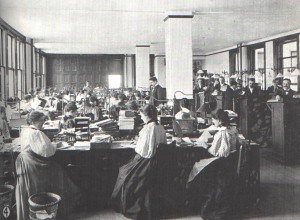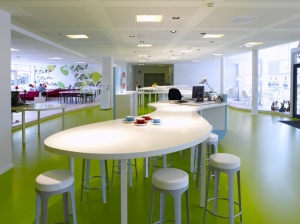Sardines
Sardines
It’s not often that my blog posts contain direct advice, preferring as I do the Socratic approach and the Veiled Magic of Questions.
But I HAVE done (and learned) some stuff over the years, and where this stuff is relatively context-free, I’m not averse to sharing.
This is also another in the intermittent series of posts highlighting observable differences between different mindsets – this time it’s office space.
The Rats’ Maze
In many businesses, much effort goes into making the workplace as well-suited as possible to the kind of work taking place. Think: factory floors, warehouses, artists’ studios, automobile workshops – even my local car wash has evolved a pretty darned effective layout for itself over the years.
In the classic, “Peopleware” by DeMarco and Lister – first published more than twenty years ago – the authors explain the significant impact that the physical environment can (and does) have on the productivity and effectiveness – not to mention engagement and motivation – of folks working in knowledge-work businesses.
I have yet to see (outside of Familiar) any organisation that even realises the scope for productivity that a suitable physical environment can offer, let alone take the trouble to find out what works (and what doesn’t) and organise their physical spaces accordingly.
At Familiar, we had around 1600 square feet of self-contained space (plus on-demand access to e.g. meeting rooms, cafeteria, etc). This self-contained space felt “full” with around eight people working in it. So, for us, our optimal density was around 200 square feet per person. This is way more that most every other work space I have ever seen. Recently I was in an office where each person had something like fifty square feet, and that’s including desk space, walkways, seating areas, etc.. Truly this was a daily game of “Sardines”.
The Analytic View of Knowledge Work
In most (i.e. Analytic-minded) organisations, folks simply assume that knowledge work is just some (slightly weird) variant of the office work we have known and loved(?) for nigh on a hundred years. Serried ranks of desks, sometimes in cube farms, or more likely these days, open-plan.
The Synergistic View of Knowledge Work
In Synergistic-minded organisations, folks recognise the fundamental differences between repetitive, relatively mindless office work, and the demands of effective knowledge work. These folks arrange their workspaces to better suit the style and nature of the work they’re doing day-in and day-out. Not only is sufficient space allocated, but the nature of the space (in fact, different kinds of space) is carefully tailored to the needs of the work. In general, these organisations perceive that knowledge work is much more like art, design, and learning than it is like office work.
In his recent video about NYU’s ITP projects “What I Learned About Creativity by Watching Creatives”, Clay Shirky describes the ITP workplace, and how both faculty and students regard the physical environment itself as as much a raw material as the items, art materials, computers, etc. in the space.
– Bob
Further Reading
Teaching Binary Math to Third Graders ~ Rick Garlikov (The Socratic Method exemplified)




Bob,
I think FogCreek might be another example of an organisation which does care about the physical space layout. Joel has, for many years, been a proponent of private offices for developers.
Here is an example I have just found: http://www.joelonsoftware.com/items/2006/07/30.html
I can see through how his view was influenced by his experience at Microsoft.
–Marcin
Going to try and apply some A3 thinking to our space problem tomorrow. Will make sure everyone reads this article before tackling the ‘what to change?’, ‘what to change to?’ and ‘how to make the change?’ questions.